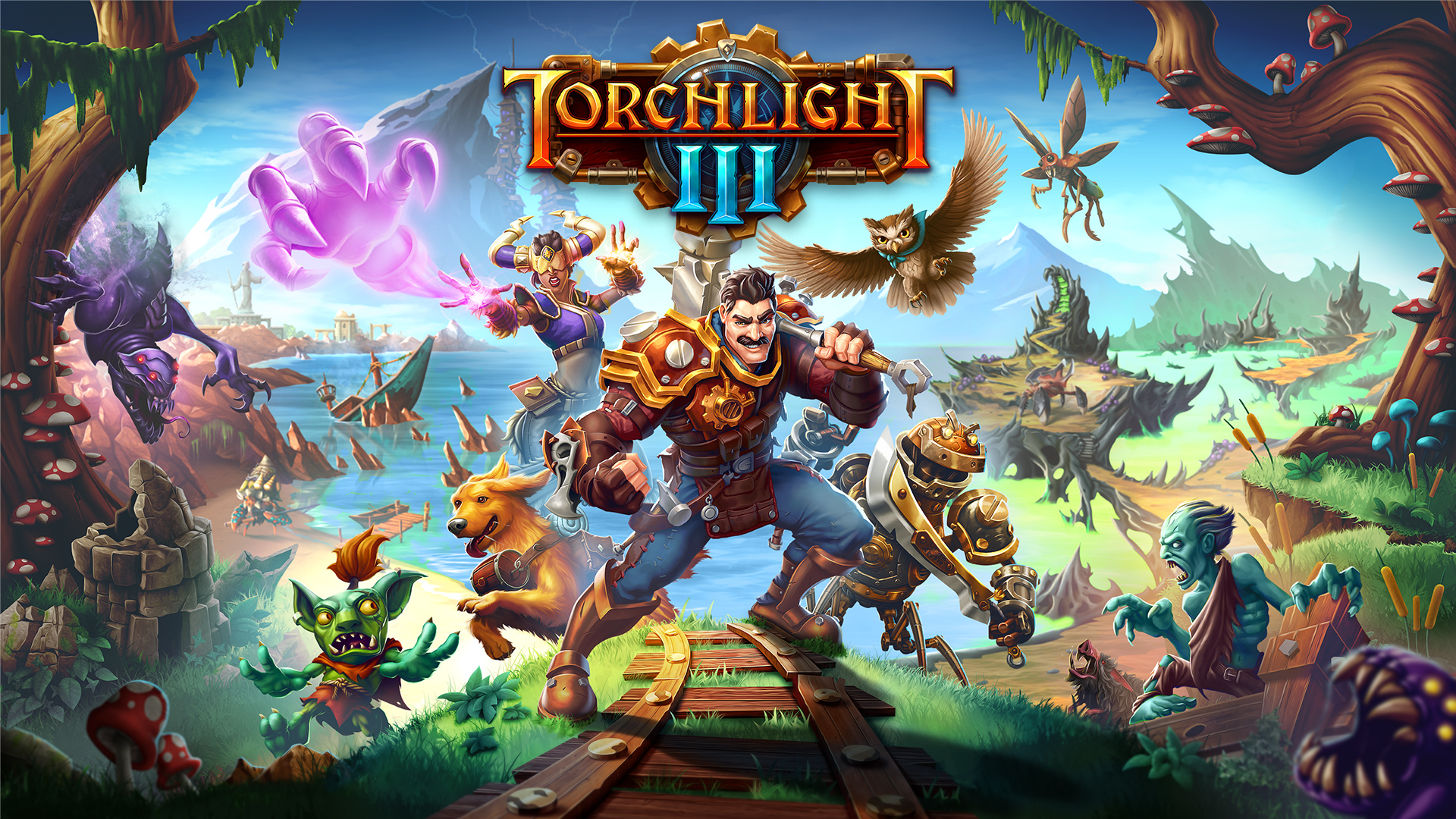Have you ever picked up a game and become so engrossed in it that it’s almost been as if the developers made it just for you? Over the course of my thirty years of gaming, that has happened to me a handful to maybe ten times. For different reasons, some titles stand out more than others, and it’s not always the triple A, 90-100% Metacritic games that do so. For instance, I’ve almost never enjoyed anything more than my first play through of Kingdoms of Amalur: Reckoning, and have now almost completed it for my fourth time. Meanwhile, whereas most fans of the genre couldn’t get enough of Diablo III, I found myself much more interested in its rival, Torchlight II. The first game was also exceptional in my book.
Don’t get me wrong, though: Diablo III was good, but I didn’t feel compelled to play through it again, which is what happened with Torchlight II. It simply wasn’t as fun to me.
After playing the original Torchlight when it came to Xbox 360, I was hopeful that the sequel — which, if I’m not mistaken, was announced not long after that — would make its way to consoles shortly after PC. That didn’t end up happening, though, as I ended up having to wait 8 years before I could play it on Xbox or PlayStation. In the meantime, I was able to buy and get it to run on an old Mac, and enjoyed every single second of it.
At the time, it seemed like that may be it for the series. A third game had been talked about, and some stuff had been shown from it, but they were talking about it being a different type of experience which didn’t interest me much at all. It seemed like it was going to be Sleeping Dogs all over again, what with the ‘sequel’ taking a different direction and becoming quickly forgotten. Then things changed, and earlier this year it was revealed that whatever they had been working on had been altered and rebranded as Torchlight III. That meant we’d finally get a proper sequel to two of my all-time favourite games.
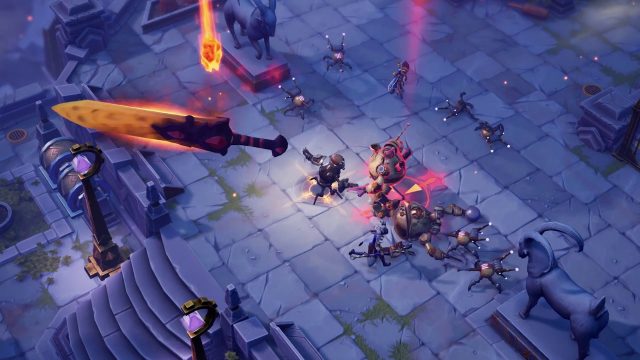
Would it be as good, though?
Set centuries after the events of its most recent predecessor, Torchlight III‘s campaign once again centres upon the all powerful void heart. It’s during this time period that we visit a Nostravia in chaos, as the Ember Empire threatens to crumble. The reason for this can be summed up in one word: Netherim. A family of them to be exact, and one which includes three bratty and annoying sisters who are doing the bidding of another, more powerful creature.
Simply put, the Netherim want to use the void heart to cause chaos and ruin a good, somewhat happy world. In order to do so, they’ve unleashed thousands upon thousands of monsters, corrupted other creatures and sent ghastly bosses out to do their bidding. This is, of course, in typical ARPG/dungeon crawler fashion.
The aforementioned storyline is there to serve a purpose, but it’s otherwise forgettable. The narrative isn’t coherent or terribly well written, the main characters are forgettable and the big baddies are more annoying than they are cool. This becomes very obvious once you find and start listening to their audio logs, which make each of the game’s three acts’ bosses sound like whiny, petulant, 12 year old girls.
I honestly stopped paying attention to them after a while.
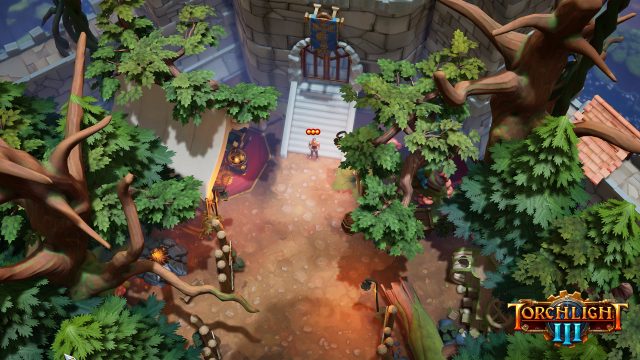
As one of several different heroes, it’s our job to stop these creatures from using the void heart to destroy the world. It won’t be easy, though, because Torchlight III is the hardest of the three games thus far, and it isn’t afraid of throwing tons of enemies at you at once. Playing in co-op would make this easier, but I went about things alone because I’m much more of a solo gamer than a cooperative one. I also didn’t have anybody to play with, because none of my friends owned the game.
Torchlight III lets players choose one of four different class types, and there are some pretty unique options this time around.
The Railmaster: A melee oriented class whose unique pet just so happens to be a train. He can lay down tracks and let his train destroy enemies that get in its way, and can also use other area clearing special attacks.
The Dusk Mage: This ranged class is able to wield both light and dark magic. She can slow enemies down with magic and attack them at the same time, while using light magic to buff herself.
The Sharpshooter: Another ranged character class, who makes use of guns and bows as opposed to magic. It’s good at using impact damage, and dealing it from a distance. That damage can add up over time. Meanwhile, the Sharpshooter is also able to summon spirits to aid its cause.
The Forged: An actual robot, which is somewhat of a tank. It uses different types of mounts to get around, including automated legs and retro minecarts, and can wield different types of weapons. For instance, you’re generally able to equip one melee or ranged weapon, such as a staff, sword, rifle or pistol. That is then coupled with the Forged’s internal chest gun, which can be changed and made better by equipping picked up loot items.
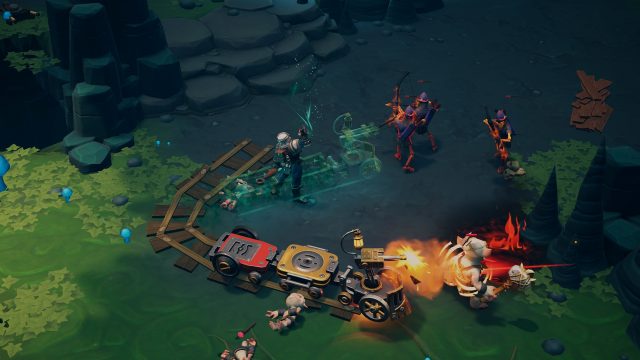
I’m somewhat boring, in that I always go for the melee class in these types of games. Reason being is that I’m not great at them, generally find magic classes boring, and like as much action as possible. It’s how I get the most fun out of these things. That said, I ended up going with the Forged for my play through of Torchlight III. The description made it seem like the most melee focused class, but after doing more research I’ve discovered that that maybe wasn’t true. I maybe should’ve picked the Railmaster.
Oh well. It’s too late now. For the first play through at least. If I ever play through this game again, I’ll choose him.
After playing through more than half of the game, I was told that the Forged is one of the harder solo classes. That may be the case. Either it is, or Torchlight III is simply more challenging than its predecessors, both of which I found to be pretty easy. Neither of my Torchlight II play throughs were too difficult, but this has been a pretty good challenge.
As the Forged, a lot of my time was spent using his chest cannon and special abilities. Before beginning my quest, I was asked to pick an elemental rune, and the one I chose was fire. That allowed me to unlock and upgrade a bunch of flame-based skills and abilities, including a massive flaming sword and a mortar-like aerial attack. Early on I used melee a lot, but as I got later into the game it became a lot more precarious.
There’s tons of loot to be found too, so it wasn’t difficult to find something new to use. I upgraded the chest cannon a tun, and used a good mix of staffs and swords for melee. One or two guns as well.
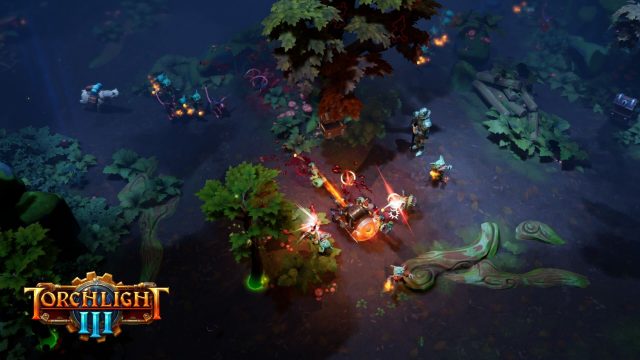
Overall, the game’s inventory system felt fine, although it was definitely cluttered. I was sending my pet to town quite often, and was happy when I received an upgrade that cut his away time from two minutes to fifteen seconds. Using the trigger buttons to cycle through pages, and the shoulder buttons to cycle through the inventory, upgrades, pet abilities and contracts (which are basically challenges that gift you things when completed) menus was a bit of a cumbersome and annoying pain, but I got used to it after a while.
The way the abilities and upgrades were displayed, over pages and without much visual subtext, wasn’t something I was a fan of though. It made upgrading a pain, and made me wish for much more traditional and streamlined skill trees.
Speaking of things I wasn’t a fan of, I must admit that I absolutely hated how Torchlight III handled potions.
As the Forged, I was able to pick up, purchase and use three different types of potions. One was a standard health potion, which cost 80 coins, while the others were more focused on getting rid of poison and electrical status effects, because those were the two main enemy elements found within the campaign. Neither one offered a lot of health assistance, but both were assigned to the same button. On top of that, I could only hold 20 potions of any sort at one time, and they had to be equipped in groups of five.
Say I had twenty regular health potions. If I used four of them, I’d be left with one equipped and fifteen standing by. When I used the remaining one of that first group of five, the next one would automatically equip. The problem with this is that, if I tried to pick up a different type of potion at that same time, it wouldn’t let me. It’d say I was over-encumbered, and had too many potions, even though I only had 16/20. It simply wouldn’t stack another type on top of the others.
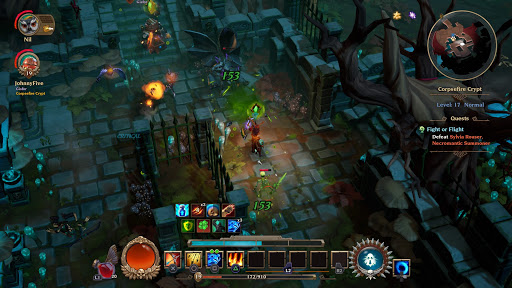
That wasn’t the worst of it, though. The worst part was the fact that only twenty potions could be equipped at any time. This meant that I couldn’t hoard health potions as I usually do, and couldn’t buy as many as I wanted for future use. As I mentioned before, Torchlight III is the hardest game in its series, so being able to do that definitely would’ve been appreciated. I ran out of potions once or twice, and the first time was during a very challenging area that had one of the game’s more difficult bosses, not to mention what felt like thousands of annoying spiders to battle.
It was certainly surprising after how easy the first two games ended up being. Challenge is good, too, so long as it’s not cheap. Torchlight III borders on cheap territory sometimes, especially since some of its bosses can practically one hit the player. The good news there is that, so long as you have enough money, you can choose whether to revive right where you fell, or at the start of that particular region. If you’d like to, you can also opt to respawn back in one of the game’s three towns. One for each act.
There were a couple of occasions where I ran out of money, but it wasn’t a huge deal.
The other thing that isn’t particularly great about this sequel is its map design. Instead of featuring open regions with sub-areas, this sequel has a board game style approach to its world map. Each of its three acts (dark forest, dingy bug infested hill and dwarf and robot heavy mountains) features multiple locations, all of which have their own landmark markers. A dotted line delineates the path between them all, and it shows that some of the smaller areas are only accessible through larger ones, which act like hubs. As such, you’ll find yourself spending a lot of time in those locations, as you clear your way towards each of their exits. If there are three different exits, only the first one will be unlocked, until you’ve cleared them all. It all depends on where your quest sends you, if that makes sense.
Not all of the map’s markers are for combat zones either. No, some mark the locations of passageways where you can travel between one area and another without having to worry about enemies. In these spots you’ll find a portal, which can be used to fast travel to any previously visited location, such as town, and will also find your fort.
What is a fort? Well, it’s basically just a player customized area and resting spot. For whatever reason, the developers decided to add materials into the mix. As such, you can expect to be able to chop down trees and use jackhammers to collect rock and metal deposits. This is all done using the A button on Xbox, and only takes a few seconds, but it can leave you open to damage if enemies are around. Your pet — of which there are many options this time around, all of which have customizable powers — will keep some at bay, though.
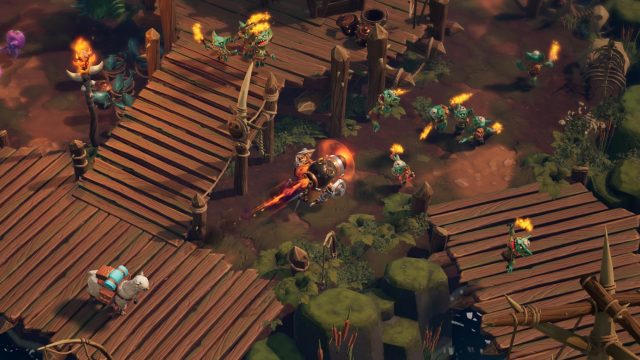
All of the wood, rock and metal that you collect can be fed into smelters and other machines in your fort. Once processed, they can then be used to build new things, including useful items and customization objects for your fort. You can also throw items into a well to increase your loot drop luck in future combat areas. Frankly, though, I fail to see the point of any of this and don’t find it particularly interesting at all.
The menu says that other players will sometimes happen by my fort during online play, but why do I care? There’s almost nothing to it, and it’s not like they can really interact with it. I wish the developers wouldn’t have bothered with these unnecessary facets, and put that extra time and effort into the campaign.
As mentioned above, the game’s campaign takes place over three different acts, and each one takes place in a different type of location. The enemies are vastly different as a result. For instance, the first act features a lot of zombies, skeletons and other such beasts. Then, the second act features a shitload of terribly annoying bugs of different types and sizes, including way too many spiders for one player to deal with at times. The third, then, takes place in the mountains, where dwarves have created industrial factories and killer robots. These robots use lots of electricity to hurt you, whereas the bugs love to dole out poison.
No matter where you are or where you go, you can also expect to run into lots of elite enemies and both sub and regular bosses. Elite enemies have purple and blue health bars, and they sometimes attack in packs. Meanwhile, bosses have golden health bars. While the game does have numerous major boss battles, which take place in their own small arenas and are often preceded by short cutscenes, it’ll send random bosses after you anywhere. Some are very easy, while others are surprisingly challenging. The difficulty level isn’t even, and it tends to fluctuate.
The problem with all of this is that, unlike before, Torchlight III‘s gameplay tends to become tedious. I never seemed to get bored of playing the original Torchlight or Torchlight II, and that’s true of both of the times I played through it to full completion, taking my time to do as much as possible in the process. It doesn’t help that there’s an overload of enemies to be found here. I know that these games are known and beloved for throwing quite a few enemies at you at once, and that that’s part of the charm, but there are too many here. You can sometimes barely move without triggering more enemies, and that really slows things down.
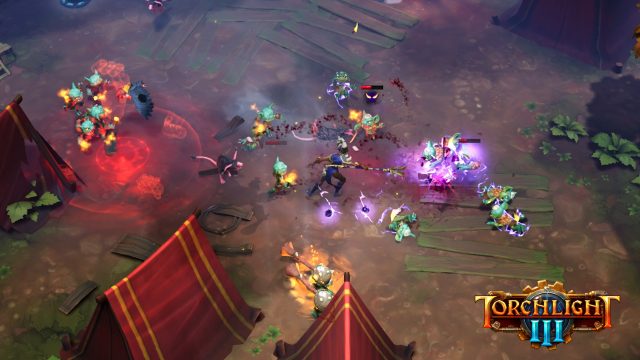
The mini-map is also quite confusing, because up until close to the end of the campaign, it didn’t really tell me where to go. Like most of its ilk, it’s supposed to have icons depicting where your objective resides. However, I didn’t see any, and had to blindly go through each location in order to try to find the exit to the next area. When it came to the big hub areas, which have multiple exists, that became a bit annoying. I’d find one that was locked, and would then have to go to the other side of that map to find what was hopefully the one I was supposed to find next.
Torchlight III simply isn’t as well designed as its predecessors, nor is it as fun. I’m glad that it exists, but it’s definitely my least favourite of the bunch. Yes, there’s definitely more to it than what the first game had to offer, but my first playthrough of it was more fun for sure.
I would be remiss if I didn’t mention that Torchlight III allows for up to four player co-op, which means that each of its four classes can be used at the same time. Meanwhile, those who complete the somewhat lengthy (20-25 hour long?) campaign will find quite a bit of endgame content. For starters, there are additional challenges and things to unlock. What’s of greatest interest, though, is the endless Dun’djinns challenge. A djinn from the second game reappears here and tasks you with completing endless dungeons with different parameters.
On top of those things, you’ll also find added ways to upgrade and customize your fort. If you’re like me, though, you won’t find that to be of much interest. The real estate is small and cramped, and it’s not like you can do much with the fort. It’s honestly really boring stuff.
If you’re someone who likes to max out their characters, or likes to exclusively play one game for a long period of time, then this endgame content will be up your alley. The endless dungeons, I mean. Reason being is that, even after you complete the main campaign, you’ll likely only be level 40 at most. The level cap is 60, and there are achievements and trophies relating to leveling each class up to 60. I honestly don’t have the time, energy or interest to do so, but some will want to. I got my fill with one play through, and don’t intend to grind to 60. I will, however, be checking out some of the post-game dungeons when I find the time.
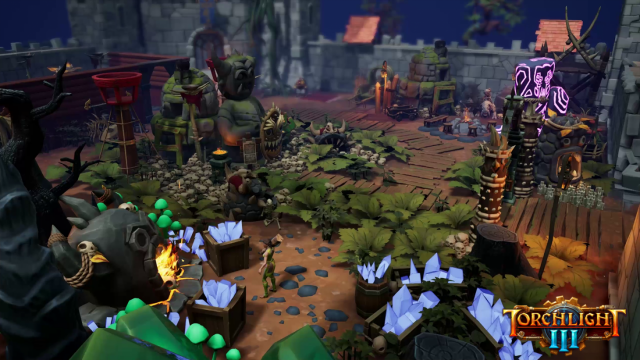
On the presentation side of things, Torchlight III is fine. There’s nothing special about it in this department, but nothing bad either. Like those before it it’s very colourful and has a good amount of personality, although the world maps tend to get kind of repetitive and boring. The voice acting is also a bit too over-the-top at times, and isn’t the best. The same is true of the writing. As I said before, the story is pretty poor and forgettable, and that doesn’t help. It’s a shame that the main enemies are so grating, annoying and bratty.
At least the music and sound effects are pretty good. That is, when they work. Actually, saying that makes it sound like they’re really problematic when they aren’t. I did, however, have one occurrence where almost all of the sound effects disappeared. All I could hear was the music, and the electricity effect whenever I made contact with an enemy. None of my weapons made any sound. On top of that, I also couldn’t progress through one area because of an invisible wall located in the middle of a staircase, and had to restart that part. When I entered another region, I immediately died and had to reload it too.
Other than that, the only bug I experienced related to the menus taking a long time to load my game once. It seemed like it was going to take forever, so I closed the game and restarted it.
Echtra Games had a lot to live up to with Torchlight III, and it honestly feels like they bit off a bit too much, by making both a campaign and a fort building experience. I wish they would’ve skipped the forts and focused solely on the campaign. If so, maybe the game would be better than it is, and less tedious by the end. As it stands now, Torchlight III is a solid but unspectacular dungeon crawler, albeit one that is definitely above average based on what I’ve played from the genre. If you really like this type of game you should get a good amount of enjoyment from it, and that’s especially true if you’re a fan of this series. That said, you will likely be disappointed if you go in expecting to to be another amazing experience like Torchlight II. It’s solid, but not nearly as good as that fantastic game.
This review is based on the Xbox One version of the game. We played it on an Xbox One X and an Xbox Series S. Perfect World Entertainment gave us review code.

